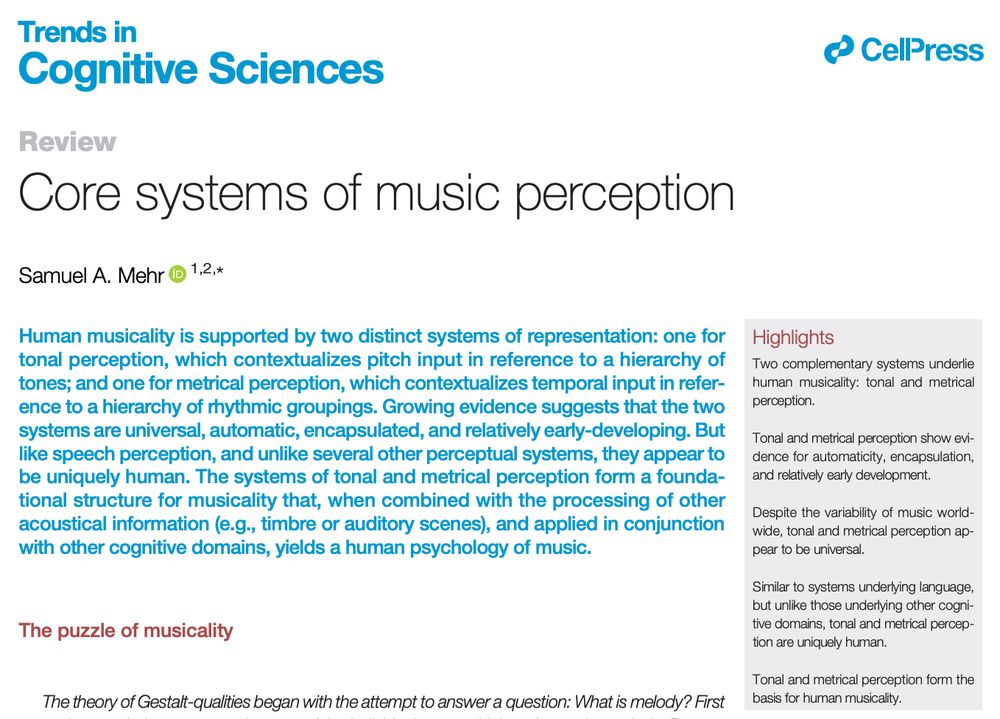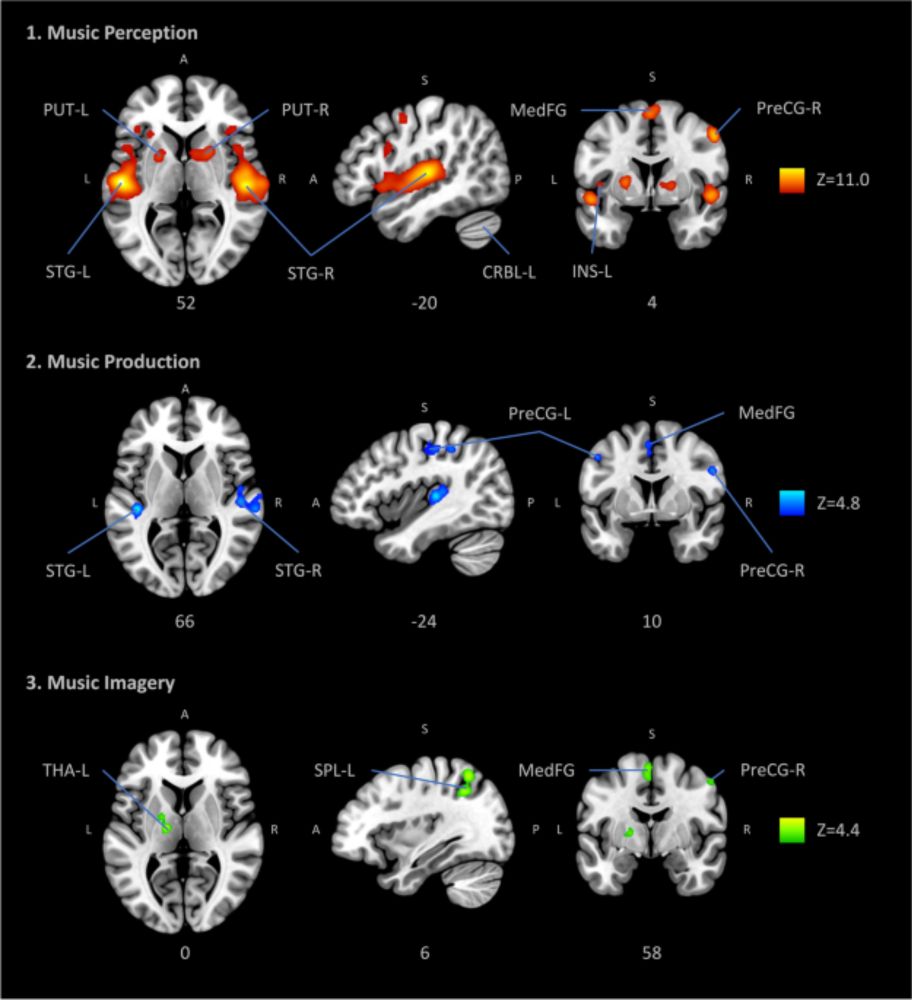Arguably the greatest concert film of all time. Of course, some would argue The Last Waltz or Woodstock or...
28.09.2025 22:00 — 👍 4 🔁 0 💬 0 📌 0
It appears to me that you have a very positive view of Trump. 😏
26.08.2025 20:23 — 👍 1 🔁 0 💬 0 📌 0
"These findings indicate that a specific brain state of musical creation is formed ... in which [neurons in] the primary visual and motor areas...are recruited to enhance the functional connectivity between the ACC and the default mode network to plan the integration of musical notes with emotion."
20.07.2025 15:51 — 👍 0 🔁 0 💬 0 📌 0

 20.07.2025 15:49 — 👍 0 🔁 0 💬 0 📌 0
20.07.2025 15:49 — 👍 0 🔁 0 💬 0 📌 0


Row A shows areas of decreased connectivity, Row E areas of increased connectivity.
Jing Lu et al The Brain Functional State of Music Creation
doi: 10.1038/srep12277.
Compared composing vs resting state fMRI of 17 composers. Stronger functional connectivity appeared between anterior cingulate cortex (ACC), right angular gyrus and bilateral superior frontal gyrus during composition.
20.07.2025 15:47 — 👍 2 🔁 0 💬 2 📌 0
Sage Journals: Discover world-class research
Subscription and open access journals from Sage, the world's leading independent academic publisher.
"This collection explores the science of learning to move and its impact on cognition, how the neuropsychological aspects of the creative movement process is manifested in the brain, and how creative movement or dance can be harnessed to enhance health, cognitive function, and quality of life."
18.06.2025 14:28 — 👍 1 🔁 0 💬 0 📌 0
The latest issue of the Journal of Alzheimer's Disease has a special section entitled "Neuropsychological impact and mechanisms of creative movement: Implications for rehabilitation for aging, neurodegenerative disease, and neurotrauma." See link and abstract below. #neuroskyence
18.06.2025 14:27 — 👍 0 🔁 0 💬 1 📌 0

Trends in
Cognitive Sciences
Review
Core systems of music perception
Samuel A. Mehr 1 ,2 , *
1 School of Psychology, University of
Auckland, Auckland, New Zealand
Human musicality is supported by two distinct systems of representation: one for
tonal perception, which contextualizes pitch input in reference to a hierarchy of
tones; and one for metrical perception, which contextualizes temporal input in reference to a hierarchy of rhythmic groupings. Growing evidence suggests that the two
systems are universal, automatic, encapsulated, and relatively early-developing. But
like speech perception, and unlike several other perceptual systems, they appear to
be uniquely human. The systems of tonal and metrical perception form a foundational structure for musicality that, when combined with the processing of other
acoustical information (e.g., timbre or auditory scenes), and applied in conjunction
with other cognitive domains, yields a human psychology of music.
my latest, in Trends in Cognitive Sciences
this review lays out what I think the fundamental specializations are for music perception in humans, namely, the hierarchical processing of pitch and rhythm
or, how our minds turn vibrating air into music
authors.elsevier.com/a/1lG9G_V1r-...
13.06.2025 21:16 — 👍 105 🔁 25 💬 7 📌 1

Curse of Neuroanatomy Training Part 4. Tessellation of Mona Lisa, but looks like gyri to us. Thanks to Dr. Jeff Browndyke. Original post by Kevin Atkinson Mathematical Tiling and Tessellation. #neuroskyence
08.05.2025 15:36 — 👍 14 🔁 4 💬 1 📌 1
"...and deactivation of angular gyrus and supramarginal gyrus, brain structures implicated in semantic processing of language... Therefore, we argue that neural regions for syntactic processing are not domain-specific for language but instead may be domain-general for communication."
07.04.2025 19:18 — 👍 2 🔁 0 💬 0 📌 0

Donnay et al doi: 10.1371/journal.pone.0088665
An fMRI Study of ‘Trading Fours’ in Jazz
Improvisation between musicians-->activation of perisylvian areas linked to processing of syntactic elements in music, including inferior frontal gyrus & posterior superior temporal gyrus... #neuroskyence
07.04.2025 19:17 — 👍 4 🔁 1 💬 1 📌 0

Gustavson et al doi: 10.1007/s10519-023-10135-0.
Parents reported on children's music experiences (N = 11,876 children). Instrument exposure... was associated with language (r = .27) and executive functions (r = .15-0.17), stronger than music listening, visual art, or soccer. #neuroskyence
05.04.2025 15:29 — 👍 8 🔁 2 💬 0 📌 1

For drummers: "The experience of groove is a trade-off between stimulus complexity (amount of syncopation) and the ability to maintain a sufficiently stable metre for moving in time with music."
30.03.2025 17:19 — 👍 3 🔁 1 💬 0 📌 0

Vuust, P et al doi: 10.1038/s41583-022-00578-5. Epub 2022 Mar 29. Music in the brain
Review of the cognitive neuroscience literature of music perception. Music perception, action, emotion & learning all rest on the human brain's fundamental capacity for prediction. #neuroskyence
30.03.2025 17:17 — 👍 14 🔁 3 💬 1 📌 0
Probably trying to maximize group differences
25.03.2025 18:47 — 👍 0 🔁 0 💬 0 📌 0
This hypothesis is supported by the strong association we found between structural differences, musician status, and practice intensity.
24.03.2025 20:31 — 👍 1 🔁 0 💬 0 📌 0
Although some of these multiregional differences could be attributable to innate predisposition, [authors] believe they may represent ... adaptations in response to long-term skill acquisition and the repetitive rehearsal of those skills.
24.03.2025 20:30 — 👍 0 🔁 0 💬 1 📌 0

Plot of grey matter differences in musicians
Gaser & Schlaug doi: 10.1523/JNEUROSCI.23-27-09240.2003. Brain structures differ between musicians and non-musicians
Gray matter volume differences in motor, auditory, & visual-spatial brain regions in pro musicians vs matched group of amateur musicians and non-musicians...
#neuroskyence
24.03.2025 20:29 — 👍 17 🔁 3 💬 3 📌 0
Elbows up, Canada!
22.03.2025 22:27 — 👍 4443 🔁 1053 💬 127 📌 258
Elbows up, Canada.
22.03.2025 22:11 — 👍 52568 🔁 13429 💬 1500 📌 2314
💃🧠 Psyched to share my latest paper in Neuron on the past, present and future of dance neuroscience research! Crazy to think where this field will be in 20 more years 🚀
authors.elsevier.com/a/1kkh3_KOmx...
#PsychSciSky #neuroskyence #Dance #CognitiveNeuroscience #Neuroaesthetics #BrainScience
22.03.2025 10:19 — 👍 40 🔁 14 💬 2 📌 2
Strong, J doi: 10.1080/13825585.2018.1448356. The cognitive functioning of older adult... musicians and non-musicians
Adult non-musicians vs low-activity musicians vs and high-activity musicians. Differences found on tasks of visual spatial ability, naming, and executive functioning. #neuroskyence
22.03.2025 19:57 — 👍 5 🔁 0 💬 0 📌 0
Singing also enhanced short-term and working memory and caregiver well-being, whereas music listening had a positive effect on quality of life.
22.03.2025 19:50 — 👍 2 🔁 0 💬 0 📌 0
Särkämö, T et al doi: 10.1093/geront/gnt100.
Cognitive, emotional, and social benefits of regular musical activities in early dementia
Compared with usual care, both singing & music listening improved mood, orientation, remote episodic memory, also attention & executive function. #neuroskyence
22.03.2025 19:50 — 👍 7 🔁 1 💬 1 📌 0
More efficient for those who were trained vs untrained later in life. A good argument for music education in schools.
15.03.2025 19:35 — 👍 2 🔁 0 💬 0 📌 0

fMRI results showing areas of more efficient processing
Saarikivi et al 2023 doi: 10.1093/cercor/bhad034.
Advantage in executive functions in musically-trained vs not trained children is more pronounced at an earlier age than in late adolescence. But there was more efficient recruitment of neural resources executive tasks after childhood. #neuroskyence
15.03.2025 15:25 — 👍 20 🔁 6 💬 1 📌 0

An ALE meta-analytic review of musical expertise - Scientific Reports
Scientific Reports - An ALE meta-analytic review of musical expertise
The second, we synthesized 84 studies comparing neuro-structural and -functional differences between musicians and non-musicians in the search of a neural signature of musical expertise.
www.nature.com/articles/s41...
03.12.2024 15:41 — 👍 1 🔁 1 💬 0 📌 0

An ALE meta-analytic review of top-down and bottom-up processing of music in the brain - Scientific Reports
Scientific Reports - An ALE meta-analytic review of top-down and bottom-up processing of music in the brain
For all #musicscience newcomers, two recent meta-analysis @musicinthebrain.bsky.social on MUSIC COGNITION and MUSIC EXPERTISE. First, we synthesised 130 studies and discussed our meta-analytic findings under the light of the predictive coding of music theory
www.nature.com/articles/s41...
03.12.2024 15:41 — 👍 23 🔁 9 💬 1 📌 0
This network constitutes an essential brain substrate for recognition of musical emotion that overlaps with brain regions previously implicated in coding emotional value, behavioural context, conceptual knowledge and theory of mind.
03.03.2025 16:43 — 👍 3 🔁 0 💬 0 📌 0
Pts with frontotemporal lobar degeneration (FTLD)
exhibit breakdown in emotional and social functioning... On neuropsychological evaluation, FTLD pts showed poor recognition of basic emotions (happiness, sadness, anger and fear) from music as well as faces and voices compared with healthy controls.
03.03.2025 16:43 — 👍 0 🔁 0 💬 0 📌 0
🎵Senior Lecturer in Music Psychology & Head of Enterprise, Royal Northern College of Music UK
🧬 Research: audiences, live music, music & Parkinson’s, music & neuroscience
🎓PhD Uni of Cambridge
📊Accountant 🎷Saxophonist
Www.WhyHumansNeedMusic.com
Neural Mechanisms of Stress Vulnerability & Resilience 🧠 | Incoming Assistant Professor @Haifa University 👨🏫 | Postdoctoral Fellow @Yale University 🎓
Music Psychologist interested in encouraging environmentally-friendly behaviour change
Psychology senior lecturer (assoc. prof) and musician. Interests: science, sound, movement, music and the mind. [He/him]
Husband, dad, veteran, writer, and proud Midwesterner. 19th US Secretary of Transportation and former Mayor of South Bend.
Data person in Seattle - Neuroimaging of Neurodegeneration - he/his
https://danjonpeterson.github.io/
Guitarist | Educator | Nashville, TN
Undergraduate researcher interested in music, language, communication, and neurodevelopment
MTSU Brain and Language Lab
VUMC Music Cognition Lab
views mine
musician/educator work: www.elizabethdaymusic.com
Professor of Music Cognition at the University of Oslo / RITMO | Music psychology, music and emotion, empathy, rhythm & social cognition
Writing a book about music preference.
Postdoc @ Neural dynamics of visual cognition (Cichy lab) @FU_Berlin
interested in language🗣️📖 and its representations in the brain🧠
https://jiawei-liiiii.github.io/
MD, PhD, Neuroscientist
Assistant Professor, Center for Music in the Brain
Department of Clinical Medicine, Aarhus University
Denmark
https://scholar.google.com/citations?user=_vU61x4AAAAJ&hl=en
https://www.au.dk/en/show/person/pandonaude@clin.au.dk
Philosopher @Flinders University in Adelaide. Author- The Emotional Mind (CUP 2018) & The Aesthetic Value of the World (OUP 2021). Lover of sci-fi & jazz piano.
https://sites.google.com/view/tomcochranephilosophy/
neuroscientist in Korea (co-director of IBS-CNIR) interested in how neuroimaging (e.g. fMRI or widefield optical imaging) can facilitate closed-loop causal interventions (e.g. neurofeedback, patterned stimulations). https://tinyurl.com/hakwan
🧠 PhD Candidate at McGill University and Douglas Research Center | frontotemporal dementia and neuroimaging | 🥨@🇨🇦
Cognitive neuropsychologist at the University of Plymouth and the Brain Research and Imaging Centre @bricplymouth.bsky.social https://www.plymouth.ac.uk/research/psychology/brain-research-and-imaging-centre
Formerly @MattNeuropsych at that other site.
Neuroscientist at @kingsioppn.bsky.social & @kingscollegelondon.bsky.social. French chatterbox and musicbox floating in a most peculiar way in Sarf London since the late 20th century...
Imagination, working memory, brains, audition, music, (i)EEG, MEG. Postdoc at University of Copenhagen. Former UC Berkeley, Aarhus Uni. Salsa dancer. Colombian.
www.neurodavid.com
where brains meet bytes // neurotechnology, privacy, security, AI and more // exploring the future of human-machine convergence
science writer | neuroscience | psychology | medicine
Neurology PGY-1, University of Rochester; OSUCOM '25. Interests in movement disorders and health policy. #neurosky #medsky
Féministe intersectionnelle en colère. ♀ NON à l'extrême-droite.
Zan, Zindagi, Azadi.
She/elle/அவள். Views = own














